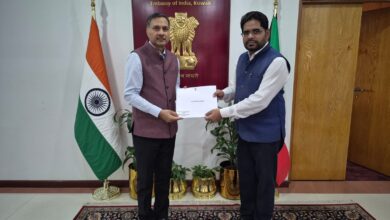India’s rise in global electronics landscape

India’s electronics sector has emerged as a crucial driver of the country’s integration into global value chains (GVCs) in the recent years. The expansion of this sector is reflective of India’s strategic efforts to deepen its involvement in the global economic framework.
Historically, the foundation of economic expansion and world domination has been manufacturing. With China leading the way with 28.4% of global manufacturing output, followed by the USA, Japan, Germany, and India, the global manufacturing value addition reached more than USD 16 trillion in 2022.
This outstanding result demonstrates how crucial manufacturing is to boosting global economic activity and job creation. Strong manufacturing sectors in a nation tend to generate large amounts of employment and encourage expansion in allied sectors, which supports a broader economic ecosystem.
India is a manufacturing powerhouse in a number of areas, with electronics developing as a key industry. With a current valuation of USD 155 billion, the Indian electronics industry has grown impressively.
Between 2017 and 2022, domestic production doubled, indicating a 13% compound annual growth rate (CAGR). Technological developments, rising domestic demand, and pro-growth government policies are the main drivers of this expansion. The sector’s growth is a reflection of India’s deliberate turn towards becoming a global manufacturing hub.
To support the electronics industry, the Indian government has launched a number of programs, such as Make in India, Digital India, the Production Linked Incentive (PLI) scheme, and the Phased Manufacturing Program (PMP). These initiatives seek to increase home production, lessen reliance on imports, and draw in foreign capital.
For example, the Make in India campaign encourages both domestic and foreign businesses to produce their goods in India, with the goal of turning the nation into a global manufacturing hub. In a similar vein, the Digital India initiative encourages improved internet access and digital infrastructure, creating an atmosphere that is favourable for the production of electronics.
Notably, 43% of India’s electronics industry currently consists of mobile phones, highlighting the sector’s explosive growth propelled by these initiatives. Specifically, the PLI plan offers financial incentives to support large-scale electronics manufacturing, increasing export capacity and production. The government’s deliberate efforts to establish India as a major player in the global electronics arena are evident in these programs, which have played a crucial role in propelling the electronics sector’s expansion.
Global Value Chains (GVCs) have revolutionized manufacturing by dividing production processes across countries, optimizing cost efficiencies, and leveraging specialization.
This shift is best seen in the electronics industry, where nations such as China, Taiwan, the USA, South Korea, Vietnam, Japan, Mexico, and Malaysia dominate different manufacturing stages and have a strong hold over the supply chain. These nations have created complex ecosystems for the electronics industry that enable them to control various parts of the value chain, from the production of components and raw materials to final assembly and distribution.
India’s participation in global electronics GVCs is expanding with enhanced integration with GVCs. The industry’s strong export recordadded $23.5 billion to India’s overall product exports in FY23, highlights its potential to take the lead in the international market. India’s electronics product exports increased from USD 5.7 billion in 2016-17 to USD 28.2 billion in 2023-24. India is now concentrating on developing its capabilities along the whole value chain, from R&D to final manufacturing and export, in order to increase its integration with GVCs.
This significant rise in exports is a testament to India’s growing prowess in the electronics sector, which has now reached among the top 3 globally during the 1st quarter 2024-25.
India’s Prime Minister, Shri Narendra Modi ji, recently expressed immense joy over this achievement, crediting the success to the innovative spirit of India’s youth, or “Yuva Shakti”. He emphasized that India remains committed to maintaining this momentum, driven by ongoing reforms and initiatives like Make in India.
Moreover, Union Minister for Electronics & Information Technology, Shri Ashwini Vaishnaw, recently highlighted in a social media post that Bharat’s electronics exports have now surged past gems and jewellery, securing the third spot among India’s top 10 exports by the end of Q1 of FY25. This milestone, driven largely by the surge in Apple iPhone exports from India, underscores the sector’s strategic importance and the impact of targeted government policies
India is now concentrating on strengthening its design capabilities and localising more high-tech components in order to become more self-sufficient and globally competitive. To stimulate additional growth and lessen reliance on imports, government support R&D investments, partnerships with leading global technology companies, and supporting legislation.
The Electronics Development Fund (EDF), PLI programs, and Semicon India Program are addressing the electronics manufacturing ecosystem as a whole. These initiatives encourage the manufacturing of goods in a number of markets, such as cellular phones, consumer electronics, telecom, IT hardware, and automotive electronics.
One of the critical areas for strategic investment is the development of a skilled workforce. India has rightly focused on enhancing the University and Induatryn linkages as partnerships between academic institutions and industry will ensure that the curriculum remains relevant and up-to-date with the latest technological advancements.
With programs like the National Logistics Policy, which attempts to lower logistics costs and increase the effectiveness of supply chains nationwide, the Indian government has already started moving in this direction for enhancing infrastructure to sustain the manufacturing sector. In the electronics industry, research and development (R&D) spending is essential to foster innovation and maintaining competitiveness. The government is rightly focused for the cutting-edge research and development to supportan environment that is created via cooperation between the government, business, and academic institutions.
The National Infrastructure Pipeline (NIP) aims to invest over $1.4 trillion in infrastructure projects across the country by 2025. This includes investments in transportation, energy, and digital infrastructure, which are vital for the electronics sector. Improved infrastructure will reduce production costs, enhance efficiency, and make Indian electronics manufacturers more competitive in global markets.
India stands at a strong foot in its journey to becoming a global leader in electronics manufacturing. The sector’s growth, bolstered by supportive government initiatives and increasing domestic consumption, demonstrates its potential to play a pivotal role in the global value chains. The collaborative efforts of the government, industry, and academia will propel India towards a future of increased self-reliance, global competitiveness, and economic prosperity. This trajectory not only promises significant job creation and economic benefits but also positions India as a key player in the global electronics landscape.
Source: TIMES OF OMAN













